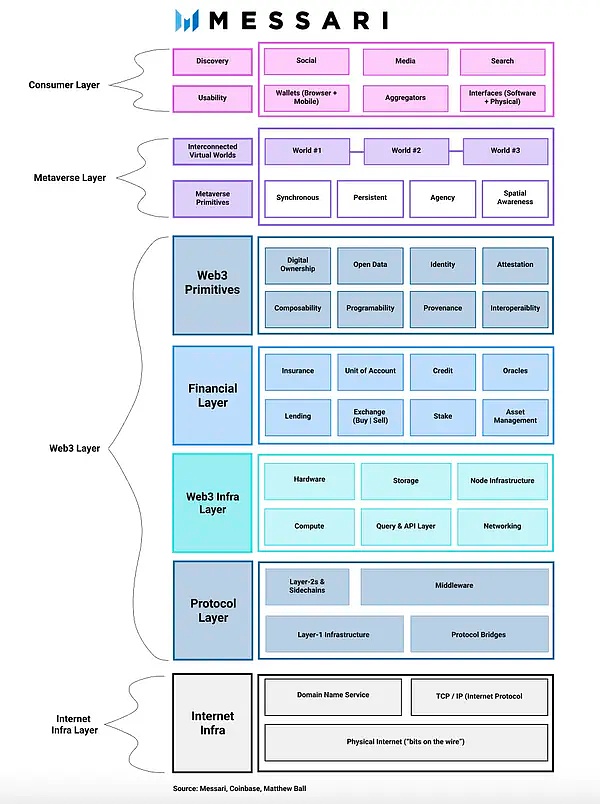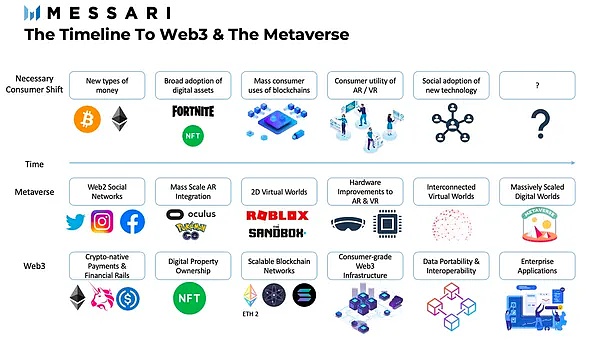A friend said that the popularity of the Metaverse has been declining recently. Yes, the bubble of fanatical hype is bursting; however, the exploration and construction of the metaverse that will allow people to work, live, study and play independently in the digital world has just begun.
Today, Metaverse is translating a Mesarri Pro report to see how author Mason Nystrom presents Web3’s role and role in the Metaverse in a concise hierarchical stack diagram.

“No one knew what it meant, but it was so exciting that it got everyone excited.”
Defining the Metaverse
The metaverse is still a loose, poorly defined term, although that hasn’t stopped well-known people or institutions from doing their best.
- Professional DJ, multi-person competition, how feeling is cloud disco in the Metaverse?
- Metaverse business pioneer Matthew Ball: China is one step closer to the Metaverse
I’ve compiled the best definitions from companies and individuals at the forefront of this field:
Meta (formerly Facebook): A place where we will play and connect in 3D.
Coinbase : The future of the internet, a large-scale, persistent, interactive, interoperable real-time platform of interconnected virtual worlds where people can socialize, work, trade, play, and create.
Pier Kicks by Bitkraft Ventures: A persistent, real-time digital universe that empowers individuals with a sense of agency, social presence and shared spatial awareness, and the ability to participate in a broad virtual economy with profound societal implications.
Matthew Ball, Epyllion Ventures: The Metaverse is a large-scale, interoperable, real-time-rendered network of 3D virtual worlds that can be effectively synchronized and persistently experienced by an unlimited number of users, with a personal presence, and with data Continuity such as identity, history, rights, objects, communications and payments.
As in the early days of the internet, definitions are largely unimportant, but the overarching theme is still relevant. From these definitions, we can weave from phrases such as “large-scale digital world” and “virtual economy (transaction and gaming)” and terms such as “synchronization”, “interconnection” and “interoperability/data portability” a common thread.
In the early days of the Internet, it was likewise classified as phrases like “real-time information,” “information network,” and “public access.” The internet eventually manifested much more than its earlier definition, but its fundamental properties remained true.
Likewise, for the Metaverse, its core value will be applications enabled by composable data, rich synchronous (shared) experiences, and a greater digital agency of personal online life. Rather than a definition that is sure to change over the next few years, we should use these properties as a guiding light for the “metaverse.”
The role of Web3 in the metaverse technology stack
We can imagine the underlying interconnected infrastructure of the Metaverse and Web3 from the point of view of the end consumer.

Consumer layer
Users interact with applications at different levels—usually at the application level or through aggregators and interfaces. Since this diagram is stacked from a consumer perspective, there should be the dominant services for how users interact with Metaverse apps: discoverability and usability.
The discoverability layer will help consumers find the metaverse, while the usability layer — mobile apps, wallets, and interfaces — abstracts the complexities of interacting with these virtual worlds for a more convenient experience. Obviously, some aggregators or interfaces have the potential to provide both.

Metaverse layer
While the jury is still out on how the metaverse will manifest, it may be easiest to think of the metaverse as an application layer. The metaverse layer is where users find virtual worlds, whether in 2D, virtual (3D), or augmented reality in the real world.
The existence of these worlds is based on the fundamental elements of the metaverse that we identified in our earlier definitions. For example, the metaverse should be synchronous — or happen at the same time. But right now, even the most talked-about virtual experiences, like the “Fortnite” concerts — which attract millions of viewers — aren’t uniform experiences.
Instead, virtual concerts are segmented into thousands of experience spaces, with a maximum of 50-100 players per experience (concert). Additionally, digital ownership enabled in the Web3 layer will be experienced in the metaverse layer (eg, a user purchases an avatar using an interface or marketplace and equips that avatar in a virtual world).

Over time, it is possible that the consumer and metaverse layers will partially merge, but in the interim, individuals may still use a similar interface or user portal before jumping into the metaverse.
Web3 layer
To visualize how the Web3 layer relates to the metaverse, it is easiest to divide it into four sub-layers:
Web3 Primitives: Properties expressed as protocols or standards, essential to the financial economy and interconnectivity of the metaverse. For example, NFTs enable digital ownership, providing users with some form of financial agency or power in a virtual world.
Financial layer: The Metaverse financial infrastructure “DeFi layer” is built on the basis of blockchain networks such as Solana and Ethereum , and is used to trade Metaverse commodities. This layer is currently the strongest in Web3, and we may see virtual worlds build their own vertically integrated marketplaces, which are then aggregated into some applications.
Web3 infrastructure layer: core infrastructure protocol and blockchain, responsible for building the decentralized backend of the metaverse, including computing, storage, query, network, etc.
Protocol layer: The basic blockchain layer, including the protocol bridge, the second layer, and the core part of the middleware.

Internet infrastructure layer
The core internet infrastructure has remained largely unchanged over the years. While some of these may change – hardware improvements, integration of encryption with Domain Name Services (DNS) (like ENS), etc. – most of the existing infrastructure will remain similarly consistent.

Where are we now?
There is still a lot of room for improvement before the Metaverse and Web3 are implemented. On the technical side, blockchain networks still need greater scalability to enable large-scale consumer applications, and the Metaverse is missing key improvements to AR and VR hardware to make these virtual worlds more convenient and enjoyable.

The past decade has seen meaningful shifts in consumer behavior as the value of digital goods—digital currencies (i.e. Bitcoin , Ethereum, stablecoins), assets (e.g. NFTs), etc. becomes ubiquitous. One of the most prominent examples is avatar skins, digital clothing in games like Fortnite, which now represent a multi-billion dollar industry.
Final Thoughts
I believe Web3 will be the base backend infrastructure of the Metaverse. Physical property rights are the basic elements of the development of nation-states, while digital property rights on the blockchain network are the basic elements of the virtual world, in which users have control and agency over their assets. Likewise, a data-portable metaverse will require blockchain networks, as these properties — composability, interoperability, digital ownership, etc. — are certainly not imbued by the centralized data monopolies that exist today.
Like what you're reading? Subscribe to our top stories.
We will continue to update Gambling Chain; if you have any questions or suggestions, please contact us!